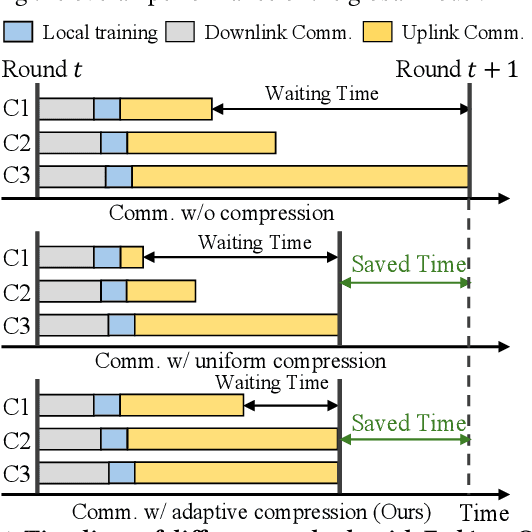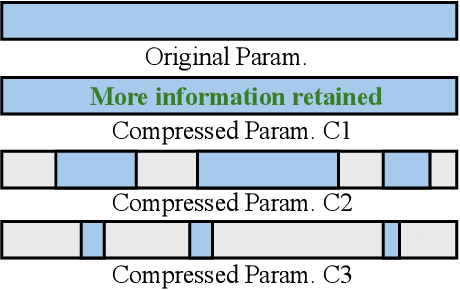Zichen Tang
GaussianIP: Identity-Preserving Realistic 3D Human Generation via Human-Centric Diffusion Prior
Mar 14, 2025Abstract:Text-guided 3D human generation has advanced with the development of efficient 3D representations and 2D-lifting methods like Score Distillation Sampling (SDS). However, current methods suffer from prolonged training times and often produce results that lack fine facial and garment details. In this paper, we propose GaussianIP, an effective two-stage framework for generating identity-preserving realistic 3D humans from text and image prompts. Our core insight is to leverage human-centric knowledge to facilitate the generation process. In stage 1, we propose a novel Adaptive Human Distillation Sampling (AHDS) method to rapidly generate a 3D human that maintains high identity consistency with the image prompt and achieves a realistic appearance. Compared to traditional SDS methods, AHDS better aligns with the human-centric generation process, enhancing visual quality with notably fewer training steps. To further improve the visual quality of the face and clothes regions, we design a View-Consistent Refinement (VCR) strategy in stage 2. Specifically, it produces detail-enhanced results of the multi-view images from stage 1 iteratively, ensuring the 3D texture consistency across views via mutual attention and distance-guided attention fusion. Then a polished version of the 3D human can be achieved by directly perform reconstruction with the refined images. Extensive experiments demonstrate that GaussianIP outperforms existing methods in both visual quality and training efficiency, particularly in generating identity-preserving results. Our code is available at: https://github.com/silence-tang/GaussianIP.
3D$^2$-Actor: Learning Pose-Conditioned 3D-Aware Denoiser for Realistic Gaussian Avatar Modeling
Dec 16, 2024



Abstract:Advancements in neural implicit representations and differentiable rendering have markedly improved the ability to learn animatable 3D avatars from sparse multi-view RGB videos. However, current methods that map observation space to canonical space often face challenges in capturing pose-dependent details and generalizing to novel poses. While diffusion models have demonstrated remarkable zero-shot capabilities in 2D image generation, their potential for creating animatable 3D avatars from 2D inputs remains underexplored. In this work, we introduce 3D$^2$-Actor, a novel approach featuring a pose-conditioned 3D-aware human modeling pipeline that integrates iterative 2D denoising and 3D rectifying steps. The 2D denoiser, guided by pose cues, generates detailed multi-view images that provide the rich feature set necessary for high-fidelity 3D reconstruction and pose rendering. Complementing this, our Gaussian-based 3D rectifier renders images with enhanced 3D consistency through a two-stage projection strategy and a novel local coordinate representation. Additionally, we propose an innovative sampling strategy to ensure smooth temporal continuity across frames in video synthesis. Our method effectively addresses the limitations of traditional numerical solutions in handling ill-posed mappings, producing realistic and animatable 3D human avatars. Experimental results demonstrate that 3D$^2$-Actor excels in high-fidelity avatar modeling and robustly generalizes to novel poses. Code is available at: https://github.com/silence-tang/GaussianActor.
Bandwidth-Aware and Overlap-Weighted Compression for Communication-Efficient Federated Learning
Aug 27, 2024



Abstract:Current data compression methods, such as sparsification in Federated Averaging (FedAvg), effectively enhance the communication efficiency of Federated Learning (FL). However, these methods encounter challenges such as the straggler problem and diminished model performance due to heterogeneous bandwidth and non-IID (Independently and Identically Distributed) data. To address these issues, we introduce a bandwidth-aware compression framework for FL, aimed at improving communication efficiency while mitigating the problems associated with non-IID data. First, our strategy dynamically adjusts compression ratios according to bandwidth, enabling clients to upload their models at a close pace, thus exploiting the otherwise wasted time to transmit more data. Second, we identify the non-overlapped pattern of retained parameters after compression, which results in diminished client update signals due to uniformly averaged weights. Based on this finding, we propose a parameter mask to adjust the client-averaging coefficients at the parameter level, thereby more closely approximating the original updates, and improving the training convergence under heterogeneous environments. Our evaluations reveal that our method significantly boosts model accuracy, with a maximum improvement of 13% over the uncompressed FedAvg. Moreover, it achieves a $3.37\times$ speedup in reaching the target accuracy compared to FedAvg with a Top-K compressor, demonstrating its effectiveness in accelerating convergence with compression. The integration of common compression techniques into our framework further establishes its potential as a versatile foundation for future cross-device, communication-efficient FL research, addressing critical challenges in FL and advancing the field of distributed machine learning.
ArtNeRF: A Stylized Neural Field for 3D-Aware Cartoonized Face Synthesis
Apr 26, 2024Abstract:Recent advances in generative visual models and neural radiance fields have greatly boosted 3D-aware image synthesis and stylization tasks. However, previous NeRF-based work is limited to single scene stylization, training a model to generate 3D-aware cartoon faces with arbitrary styles remains unsolved. We propose ArtNeRF, a novel face stylization framework derived from 3D-aware GAN to tackle this problem. In this framework, we utilize an expressive generator to synthesize stylized faces and a triple-branch discriminator module to improve the visual quality and style consistency of the generated faces. Specifically, a style encoder based on contrastive learning is leveraged to extract robust low-dimensional embeddings of style images, empowering the generator with the knowledge of various styles. To smooth the training process of cross-domain transfer learning, we propose an adaptive style blending module which helps inject style information and allows users to freely tune the level of stylization. We further introduce a neural rendering module to achieve efficient real-time rendering of images with higher resolutions. Extensive experiments demonstrate that ArtNeRF is versatile in generating high-quality 3D-aware cartoon faces with arbitrary styles.
ChatKBQA: A Generate-then-Retrieve Framework for Knowledge Base Question Answering with Fine-tuned Large Language Models
Oct 13, 2023Abstract:Knowledge Base Question Answering (KBQA) aims to derive answers to natural language questions over large-scale knowledge bases (KBs), which are generally divided into two research components: knowledge retrieval and semantic parsing. However, three core challenges remain, including inefficient knowledge retrieval, retrieval errors adversely affecting semantic parsing, and the complexity of previous KBQA methods. In the era of large language models (LLMs), we introduce ChatKBQA, a novel generate-then-retrieve KBQA framework built on fine-tuning open-source LLMs such as Llama-2, ChatGLM2 and Baichuan2. ChatKBQA proposes generating the logical form with fine-tuned LLMs first, then retrieving and replacing entities and relations through an unsupervised retrieval method, which improves both generation and retrieval more straightforwardly. Experimental results reveal that ChatKBQA achieves new state-of-the-art performance on standard KBQA datasets, WebQSP, and ComplexWebQuestions (CWQ). This work also provides a new paradigm for combining LLMs with knowledge graphs (KGs) for interpretable and knowledge-required question answering. Our code is publicly available.
Text2NKG: Fine-Grained N-ary Relation Extraction for N-ary relational Knowledge Graph Construction
Oct 12, 2023Abstract:Beyond traditional binary relational facts, n-ary relational knowledge graphs (NKGs) are comprised of n-ary relational facts containing more than two entities, which are closer to real-world facts with broader applications. However, the construction of NKGs still significantly relies on manual labor, and n-ary relation extraction still remains at a course-grained level, which is always in a single schema and fixed arity of entities. To address these restrictions, we propose Text2NKG, a novel fine-grained n-ary relation extraction framework for n-ary relational knowledge graph construction. We introduce a span-tuple classification approach with hetero-ordered merging to accomplish fine-grained n-ary relation extraction in different arity. Furthermore, Text2NKG supports four typical NKG schemas: hyper-relational schema, event-based schema, role-based schema, and hypergraph-based schema, with high flexibility and practicality. Experimental results demonstrate that Text2NKG outperforms the previous state-of-the-art model by nearly 20\% points in the $F_1$ scores on the fine-grained n-ary relation extraction benchmark in the hyper-relational schema. Our code and datasets are publicly available.
HAHE: Hierarchical Attention for Hyper-Relational Knowledge Graphs in Global and Local Level
May 15, 2023Abstract:Link Prediction on Hyper-relational Knowledge Graphs (HKG) is a worthwhile endeavor. HKG consists of hyper-relational facts (H-Facts), composed of a main triple and several auxiliary attribute-value qualifiers, which can effectively represent factually comprehensive information. The internal structure of HKG can be represented as a hypergraph-based representation globally and a semantic sequence-based representation locally. However, existing research seldom simultaneously models the graphical and sequential structure of HKGs, limiting HKGs' representation. To overcome this limitation, we propose a novel Hierarchical Attention model for HKG Embedding (HAHE), including global-level and local-level attention. The global-level attention can model the graphical structure of HKG using hypergraph dual-attention layers, while the local-level attention can learn the sequential structure inside H-Facts via heterogeneous self-attention layers. Experiment results indicate that HAHE achieves state-of-the-art performance in link prediction tasks on HKG standard datasets. In addition, HAHE addresses the issue of HKG multi-position prediction for the first time, increasing the applicability of the HKG link prediction task. Our code is publicly available.
NQE: N-ary Query Embedding for Complex Query Answering over Hyper-relational Knowledge Graphs
Nov 24, 2022Abstract:Complex query answering (CQA) is an essential task for multi-hop and logical reasoning on knowledge graphs (KGs). Currently, most approaches are limited to queries among binary relational facts and pay less attention to n-ary facts (n>=2) containing more than two entities, which are more prevalent in the real world. Moreover, previous CQA methods can only make predictions for a few given types of queries and cannot be flexibly extended to more complex logical queries, which significantly limits their applications. To overcome these challenges, in this work, we propose a novel N-ary Query Embedding (NQE) model for CQA over hyper-relational knowledge graphs (HKGs), which include massive n-ary facts. The NQE utilizes a dual-heterogeneous Transformer encoder and fuzzy logic theory to satisfy all n-ary FOL queries, including existential quantifiers, conjunction, disjunction, and negation. We also propose a parallel processing algorithm that can train or predict arbitrary n-ary FOL queries in a single batch, regardless of the kind of each query, with good flexibility and extensibility. In addition, we generate a new CQA dataset WD50K-NFOL, including diverse n-ary FOL queries over WD50K. Experimental results on WD50K-NFOL and other standard CQA datasets show that NQE is the state-of-the-art CQA method over HKGs with good generalization capability. Our code and dataset are publicly available.
 Add to Chrome
Add to Chrome Add to Firefox
Add to Firefox Add to Edge
Add to Edge